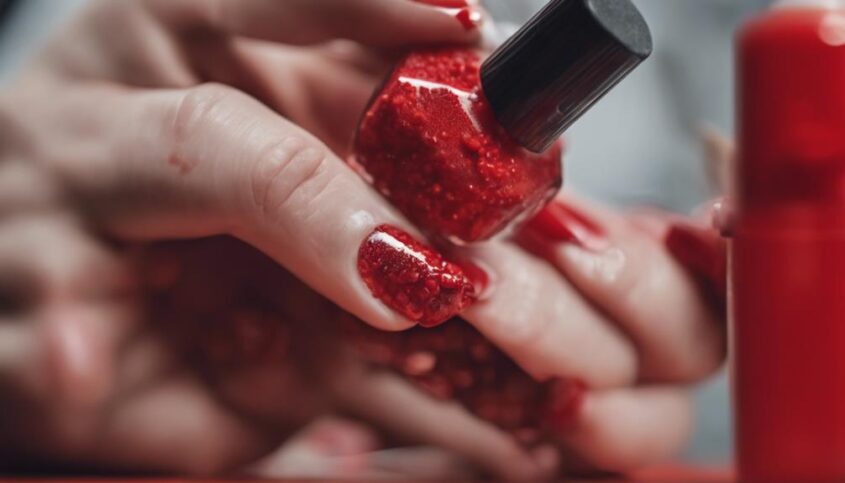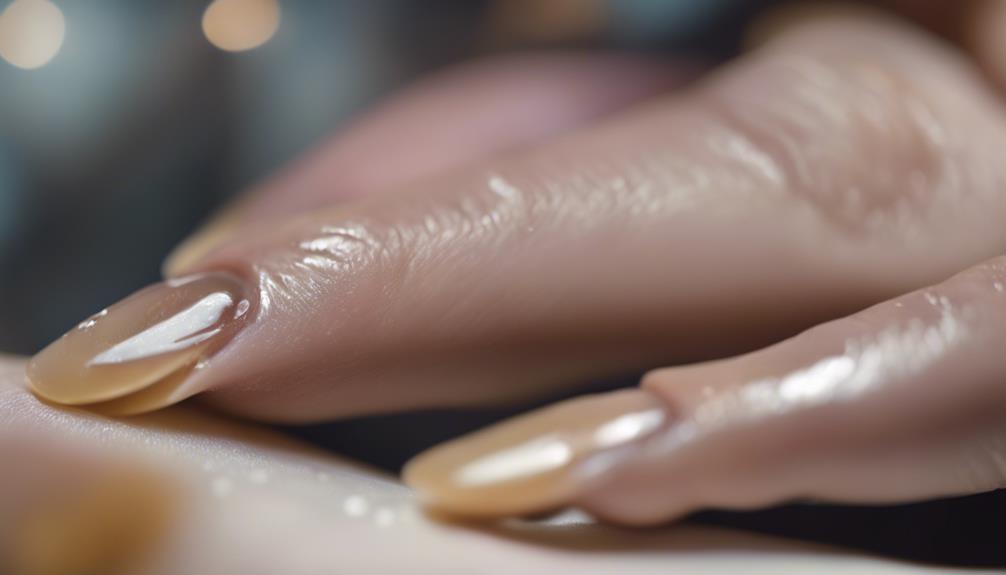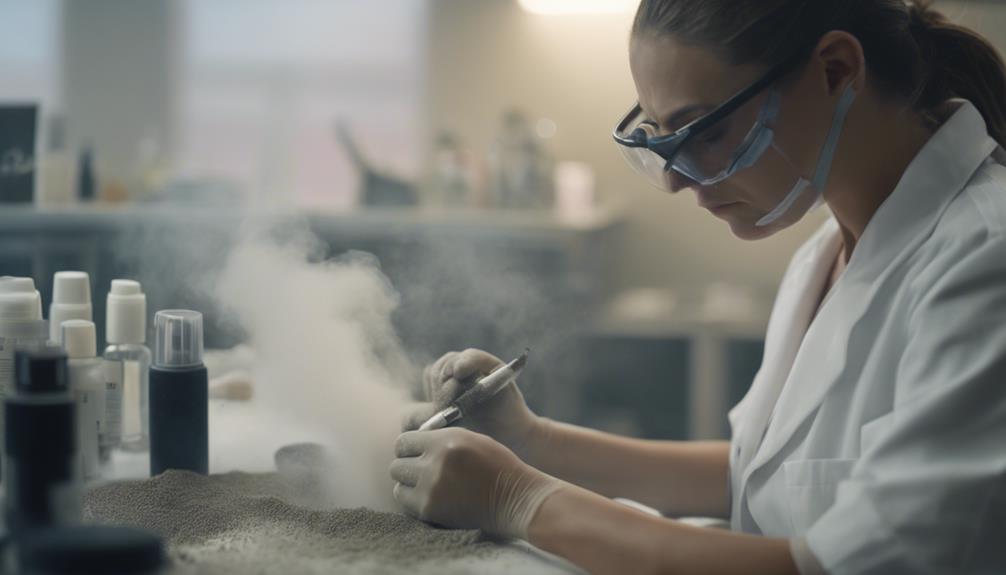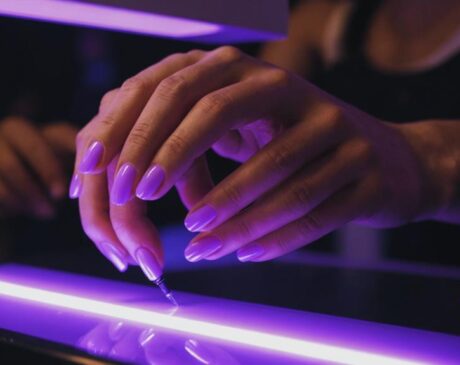What Diseases Do Nail Technicians Get?

As a nail technician, you can develop fungal infections from moist environments. Dermatitis may arise due to chemical exposure, leading to redness and itching. Protect yourself by using gloves and moisturizing your hands. Chemical burns are preventable with proper gear and ventilation. Be cautious of allergic reactions to nail products; opt for hypoallergenic options. Respiratory issues can be minimized with air purifiers and masks. Take care of your body to prevent musculoskeletal disorders by using ergonomic tools and taking breaks. Understanding these risks is crucial for your health and career longevity.
Key Takeaways
- Fungal Infections: Thrive in moist environments, spread easily without hygiene, treatable with antifungal medications.
- Dermatitis: Caused by chemicals in nail products, prevent with gloves and moisturizing, use hypoallergenic products.
- Chemical Burns: Use protective gear, opt for safer products, train on safe handling, prevent with innovation.
- Allergic Reactions: Minimize risk with hypoallergenic products, proper ventilation, wear gloves, stay informed on safe practices.
- Respiratory Issues: Invest in air purifiers, use ventilation, wear protective equipment, take regular fresh air breaks.
Fungal Infections

Do you know how fungal infections can affect nail technicians? Working in a salon, you're constantly exposed to moisture, which creates the perfect environment for fungus to thrive. Fungal infections like onychomycosis can easily spread from client to technician if proper hygiene practices are not followed. These infections can cause discoloration, thickening, and brittleness of the nails, making it not only unsightly but also uncomfortable to work with.
To combat fungal infections, it's crucial to maintain strict cleanliness standards in your workspace. Regularly disinfecting your tools, washing your hands thoroughly between clients, and using disposable items whenever possible can help prevent the spread of fungi. Additionally, wearing gloves can act as a barrier between your skin and potentially infected nails.
Innovations in antifungal treatments have made it easier to address these infections promptly. From topical creams to oral medications, nail technicians now have various options to effectively treat fungal infections. By staying informed and proactive, you can protect yourself and your clients from the risks associated with fungal nail infections.
Dermatitis
Constant exposure to irritants and allergens in the salon environment can lead to the development of dermatitis among nail technicians. Dermatitis is a common skin condition that causes redness, itching, and swelling. As a nail technician, your hands are constantly in contact with various chemicals present in nail products, sanitizers, and cleaning agents, making you more susceptible to developing this condition. The repeated exposure to these substances can disrupt the natural barrier of your skin, leading to inflammation and discomfort.
To combat dermatitis, it's essential to use protective gloves while handling chemicals and to moisturize your hands regularly to maintain skin hydration. Opt for hypoallergenic products and avoid using harsh chemicals whenever possible. Additionally, incorporating barrier creams into your skincare routine can provide an extra layer of protection for your hands.
Chemical Burns

Exposure to corrosive substances in the salon setting can increase the risk of chemical burns among nail technicians. To mitigate this risk, consider the following innovative measures:
- Use Protective Gear: Embrace advanced protective gear like chemical-resistant gloves and aprons to shield your skin from harmful substances.
- Implement Ventilation Systems: Install cutting-edge ventilation systems to ensure proper airflow and reduce the concentration of potentially dangerous fumes in the salon.
- Opt for Safer Products: Explore the latest developments in nail care products, opting for those with fewer harsh chemicals to decrease the risk of chemical burns.
- Regular Training: Engage in continuous education on safe handling procedures for chemicals, staying updated on the latest techniques to prevent accidents and burns.
Allergic Reactions
Minimizing the risk of allergic reactions is crucial for your well-being as a nail technician in the salon environment. Allergic reactions can occur due to exposure to chemicals present in nail products like acrylics, gels, polishes, and removers. These reactions can range from mild skin irritation to severe allergic dermatitis, causing discomfort and potentially impacting your ability to work.
To innovate in preventing allergic reactions, consider using hypoallergenic products or those labeled as "5-free" or "7-free", indicating they are free from certain harmful chemicals. Implementing proper ventilation systems can also help reduce the concentration of fumes that may trigger allergic responses. Additionally, wearing gloves while handling chemicals and ensuring thorough hand washing can minimize skin contact and the likelihood of developing sensitivities.
Regularly updating your knowledge on safe chemical handling practices and staying informed about new product formulations can aid in avoiding potential allergens. Prioritizing your health by taking proactive measures to prevent allergic reactions will contribute to a safer and more sustainable work environment for you as a nail technician.
Respiratory Issues

Ensuring proper ventilation in your salon workspace is crucial for safeguarding against respiratory issues as a nail technician. Poor air quality can lead to various respiratory problems, so here are some innovative ways to protect your respiratory health:
- Invest in Air Purifiers: Consider using air purifiers equipped with HEPA filters to remove harmful particles and chemicals from the air, creating a cleaner breathing environment.
- Utilize Local Exhaust Ventilation: Install ventilation systems near your work area to capture and remove chemical fumes and dust before they disperse into the salon air.
- Use Respiratory Protective Equipment: Wear masks or respirators designed to filter out airborne contaminants while working with acrylics, polishes, and other potentially harmful substances.
- Implement Regular Breaks Outside: Step outside periodically to breathe in fresh air and give your respiratory system a break from the indoor salon environment.
Musculoskeletal Disorders
To protect yourself from musculoskeletal disorders as a nail technician, it's imperative to maintain proper ergonomics while working in the salon. Your work may involve repetitive motions and awkward postures that can lead to strains and injuries. Embracing innovative tools like ergonomic chairs, adjustable tables, and wrist rests can significantly reduce the risk of musculoskeletal issues. Remember to position yourself at the right height to avoid leaning over excessively, which can strain your back and neck.
Innovations like electric nail drills with ergonomic designs can also lessen the strain on your hands and wrists. Take regular breaks to stretch and relax your muscles, incorporating simple exercises to improve circulation and flexibility. Engage in activities outside of work that promote overall strength and endurance, such as yoga or Pilates. Prioritizing your physical well-being through these innovative approaches will not only benefit your current health but also safeguard your future as a nail technician.
Nail Disorders

Maintaining healthy nails is essential for nail technicians to ensure their own well-being and professional success. As a nail technician, it's crucial to be aware of common nail disorders that may arise due to constant exposure to chemicals and repetitive tasks. Here are some innovative insights into nail disorders:
- Onychomycosis: This fungal infection can affect both the nails and surrounding skin, leading to discoloration, thickening, and brittleness.
- Paronychia: An infection that occurs around the nail fold, causing redness, swelling, and pain. Proper hygiene practices are essential to prevent this condition.
- Nail Pitting: Small depressions or holes in the nail plate can be a sign of various conditions, including psoriasis or alopecia areata.
- Allergic Contact Dermatitis: Reaction to chemicals like acrylates or formaldehyde can result in red, itchy, and inflamed skin around the nails. Using gloves and hypoallergenic products can help mitigate this risk.
Frequently Asked Questions
Can Nail Technicians Transmit Diseases to Clients?
Yes, nail technicians, like any professionals in close contact with clients, can potentially transmit diseases if proper hygiene protocols are not followed. Regular handwashing, sanitization, and use of clean tools are crucial.
What Safety Measures Can Prevent Nail Technician Health Issues?
Imagine your health as a delicate garden. By implementing proper ventilation, wearing protective gear, and maintaining good hygiene practices, you can shield yourself from potential health issues as a nail technician. Your well-being matters.
Are There Any Long-Term Effects of Working With Chemicals?
Working with chemicals long-term can lead to various health concerns. Protect yourself by using proper ventilation, wearing gloves, and taking breaks. Prioritize your well-being to prevent long-term effects and maintain your health while pursuing your passion.
How Common Are Infections Among Nail Technicians?
In the world of nail artistry, infections can be a concern. With meticulous attention to hygiene, infections among nail technicians are often preventable. Stay vigilant, implement best practices, and prioritize your health.
Can Poor Ventilation in Salons Lead to Health Problems?
When ventilation lacks in salons, you risk health troubles. Poor air quality can lead to respiratory issues, headaches, and fatigue. Upgrade your salon's ventilation to safeguard your well-being and create a healthier work environment.




